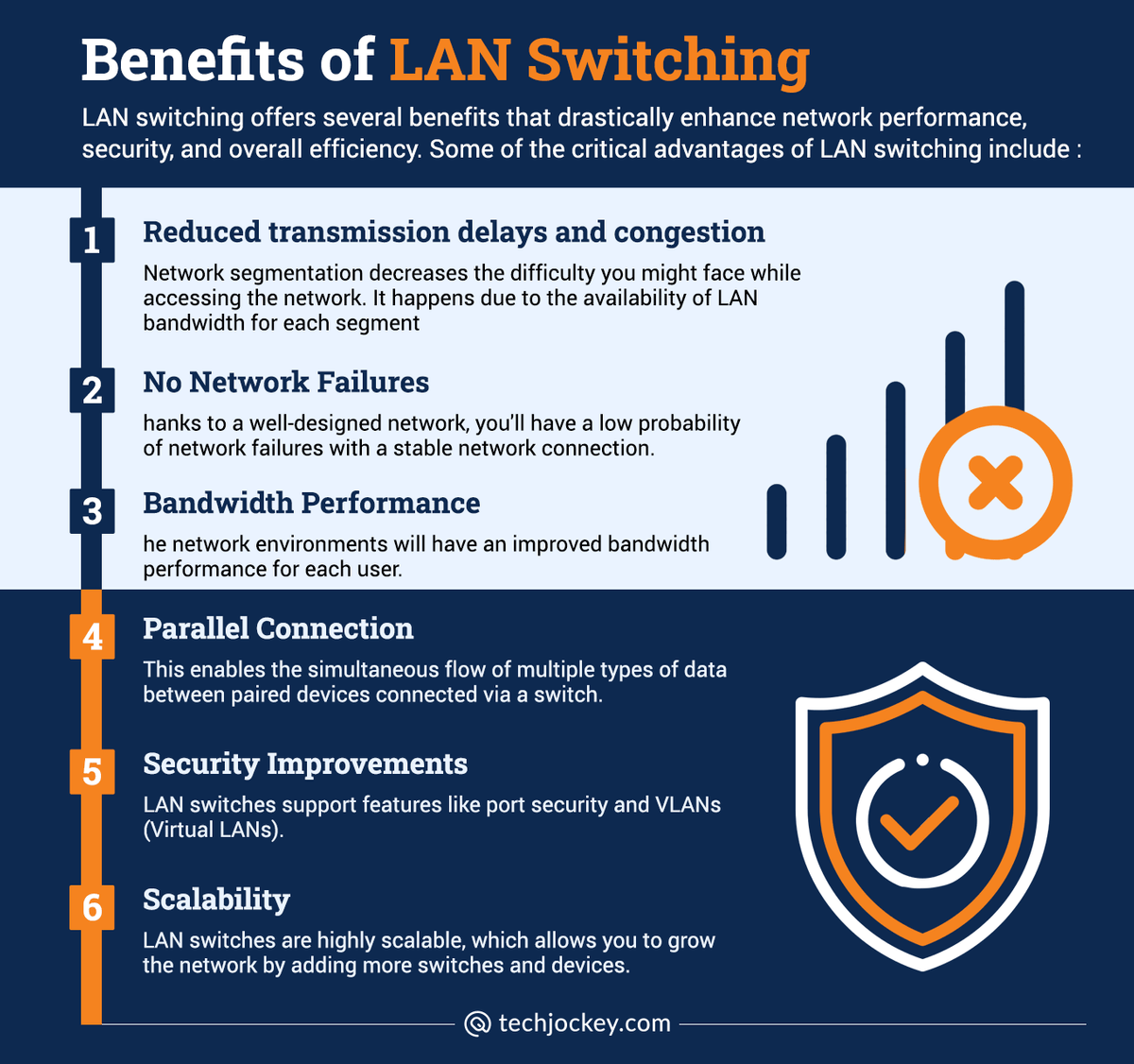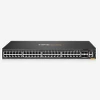How to Improve Network Security & Efficiency with LAN Switching

For several businesses, a slow, unreliable, and unsecured network can be disastrous in the long run. Cloud applications that take a lot longer to load can affect the employee’s productivity. The cost of a bad network is higher downtime and loss of productivity.
So, what’s the right solution to mitigate this problem? The answer is LAN switching, as it plays a vital role in enhancing both network security and efficiency. By using LAN switches, your organization can improve data transfer speed, reduce network congestion, and implement various security measures to protect local area networks.
In this article, we are going to discuss a few benefits of using LAN switching, how it works, and how it improves network speed and performance.
What is LAN Switching?
LAN switching is the process of using a network switch to transfer data packets between devices within a local area network (LAN). A LAN switch operates at the data link layer of Open Systems Interconnection (OSI) model and uses MAC (Media Access Control) addresses to determine the destination of data packets.
In conventional LANs, devices like computers, servers, and printers are connected to the LAN switch to form a network. When a device on the network wants to communicate with another device, it transmits data in the form of packets.
After which, the LAN switch analyzes MAC address of the data packet to determine the port to which the destination device is connected. The packet is subsequently forwarded to the proper port, which reduces unnecessary network traffic and increases productivity.
How Does LAN Switches Work?

The primary function of Local Area Network (LAN) switches is to forward data packets between devices within a local network. LAN switches work as per
Media Access Control (MAC) addresses and use a technique known as “packet switching” to ensure fast and efficient data transfer. Let’s have a view at its detailed working procedure.
- Learning MAC addresses: When a LAN switch starts operating, in the beginning, it doesn’t have any info about the devices connected to its ports. But, as it gets data frames, the source MAC address of every frame is examined to find the devices that are connected to each switch port.
- Constructing MAC Address Table: As data frames from several sources enter the switch, it generates a MAC address table, which is also known as CAM table or MAC address forwarding table. This table matches the relevant switch ports with MAC addresses, and the switch maps each MAC address with the port from which it obtained the data frame.
- Forwarding Decisions: After populating the MAC address table, the switch makes intelligent forwarding decisions. When a data frame with a particular MAC address (the destination MAC address) enters the switch, the switch checks its MAC address table to find out which port the destination device is connected to.
- Effective Forwarding: Unlike traditional network devices like hubs that simply broadcast data frames to all attached devices, LAN switches only forward data frames to the port that is closest to the destination device. This improves the overall network efficiency and minimizes unnecessary traffic.
- Loop Avoidance: LAN switches use the spanning tree protocol to avoid network loops which can lead to network instability and cause broadcast storms. To provide network redundancy and avoid loops, STP makes sure there is always just one active path between any two switches.
- Broadcast & Unknown Unicast Flooding: If the LAN switch gets a Unicast frame or broadcast frame with an unknown MAC address, it will broadcast the frame across all ports (but not the port from which it was received). This ensures that broadcast frames are received by all LAN-connected devices plus it allows the response from all unknown MAC addresses. It helps in updating the switch’s MAC address table.
What are the Benefits of LAN Switching?

LAN switching offers several benefits that drastically enhance network performance, security, and overall efficiency. Some of the critical advantages of LAN switching include:
- Reduced transmission delays and congestion: Network segmentation decreases the difficulty you might face while accessing the network. It happens due to the availability of LAN bandwidth for each segment. Moreover, the network can expand on its own depending on the capacity of your business.
- No Network Failures: Thanks to a well-designed network, you’ll have a low probability of network failures with a stable network connection.
- Bandwidth Performance: The network environments will have an improved bandwidth performance for each user. There will be no communication delays and users can easily interact with client server database or use multimedia applications.
- Parallel Connection: This enables the simultaneous flow of multiple types of data between paired devices connected via a switch. You don’t get this feature on a hub-based network connection.
- Security Improvements: LAN switches support features like port security and VLANs (Virtual LANs). VLANs allows the logical segmentation of the network, restricting communication between multiple segments and improving security. Port security features control access to switch ports, preventing unauthorized devices from accessing the network.
- Scalability: LAN switches are highly scalable, which allows you to grow the network by adding more switches and devices. The use of switches instead of hubs also makes it easier to extend the network without compromising performance.
How Does Aruba LAN Switching Improves Network Speed & Performance?
Aruba LAN switching solutions use advanced features and technology to reduce network congestion, enhance data transfer speed, and optimize network operations. Here’s how Aruba LAN switching improves network performance:
- Quality of Service: Aruba switches provide cutting-edge QoS capabilities that give utmost priority to important network traffic like audio and video data. By distributing bandwidth and giving priority to time-sensitive applications, QoS guarantees a consistent and dependable user experience for critical applications.
- High Speed Connectivity: Aruba switches support gigabit Ethernet and multi gigabit Ethernet connections, which ensure high speed connectivity to servers and endpoints. These allow faster data transfer between multiple devices, thus improving the overall network performance.
- Dynamic Buffering: The offered switching solutions feature dynamic buffer allocation, which ensures optimal usage of available buffer resources. They prevent buffer congestion and decrease packet loss at the time of network congestion, improving the performance of both real time and non-real time traffic.
- Smart Traffic Management: Aruba switching solutions use smart traffic management technology to optimize the data flow. It includes features like port mirroring, flow control and broadcast control for efficiently managing the traffic and reducing unnecessary broadcast storms.
- Link Aggregation: Aruba LAN switches support link aggregation (LAG) also known as port trunking. It helps merge multiple physical links between switches or devices into a single logical link. Moreover, LAG improves the available bandwidth and network performance.
- Jumbo Frames: Larger data frames, or jumbo frames, can transmit more information in a single transfer while using less bandwidth than smaller frames. Aruba switches enable the use of jumbo frames, which can carry larger data packets and lead to reduced overhead cost and improvement in data transfer rates.
- Upgrade to faster interfaces: If your current Aruba switches support Gigabit Ethernet but you need higher speed, then you must upgrade to Aruba switches with Multi-Gigabit Ethernet (2.5Gbps, 5Gbps, or 10Gbps) interfaces. Thanks to these high-speed interfaces, you can enjoy faster data transfer between servers and devices, thus improving the overall network performance.
- Flow Control: The flow control mechanism in Aruba switches helps in regulating the data flow during network congestion. Moreover, it can prevent packet drops and enhance network performance under high load conditions.
- Network Monitoring & Optimization: Aruba switches come with comprehensive monitoring and diagnostic tools that enable network administrators to identify and address potential bottlenecks or performance issues. Moreover, regular network monitoring and optimization ensure seamless speed and efficiency.
Conclusion
A lag free and secure network performance results in customer satisfaction, optimal performance, and high efficiency. On the other hand, the impact of an unreliable network is downtime, user frustration and loss of productivity.
If you want to speed up your operations or take your business to the pinnacle of success, then you must opt for Aruba LAN switches. The offered range allows efficient and smooth communication between different network connection points.
These easy to deploy, and affordable switches are designed with both small- and large-scale businesses in mind. Additionally, the advanced and smartly managed switches ensure enhanced performance and consistent connectivity of today’s bandwidth-heavy applications.
Danish Jacob is a goal-driven and accomplished professional with over 8 years of work experience in Content Writing and Digital Marketing. He holds a degree in M.A.-(English Literature and Language) from Jaipur National University and currently pursuing an MBA in Marketing from Manipal University Jaipur. Owing to the... Read more




























